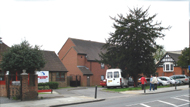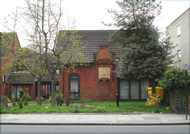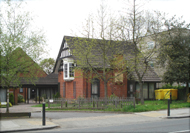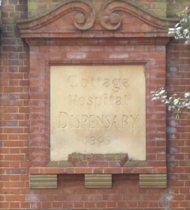Blackheath & Charlton Hospital
Shooters Hill Road, Blackheath, SE3
Medical dates:
Medical character:
1880 - 1948
Acute
In 1878 the Revd John William Marshall (1836-1915), of the
parish of St John the Evangelist at St John's Park, formed a local
committee with a view to establishing a hospital similar to that at
Beckenham.
A house in Bowater Place, off the Old Dover Road, served as the first
building for the Blackheath Cottage Hospital, which opened in 1880.
It had four beds - two for male patients and two for females.
The first operation to be performed was a leg amputation, which
was successfully carried out.
In 1883 it changed its name to the Blackheath and Charlton Cottage
Hospital. The following year it moved to larger premises.
Two houses - Nos. 1 and 2 Avenue Villas - in the Old Dover Road
had been purchased and the accommodation increased to 10 beds and 5
cots. In that year the Hospital treated 89 in-patients, only five
of whom died. In 1887 an Out-Patients Department opened.
By 1888 the committee had sufficient funds to build a purpose-built
hospital on land donated by the Earl of St Germans. The new
Blackheath and Charlton Cottage Hospital was officially opened in 1889
by Queen Victoria's daughter, Princess Christian of Schleswig-Holstein.
In 1892 131 in-patients were treated, of whom 8 died. The
Hospital enjoyed a good reputation and a local reporter declared that
"people did not die here unless they must".
A dispensary was added in 1904 and, in the following year, electric lighting and a telephone system.
The Hospital changed its name in 1911, dropping the word 'Cottage'.
In 1913 the neighbouring house at 150 Shooters Hill Road was
bought for use as a Nurses' Home. An X-ray Department was
installed in 1914.
At the beginning of WW1 a ward with 12 beds was reserved for military casualties, staffed by the members of a local Voluntary Aid Detachment. (The Kent Voluntary Aid Detachments
(VAD), which operated throughout WW1, also set up and ran over 80
auxiliary military hospitals in private houses, schools and church
halls to receive wounded soldiers from the battlefields.) By
March 1915 the reserved ward at the Hospital was occupied by wounded
servicemen.
In 1928 the Hospital opened a new wing which had been built in memory
of Dr Peter Copper (1854-1927), a local worthy. It had cost
£2000 and was opened officially by a past Honorary Secretary,
Miss Mildred Sargeaunt.
By 1935 further improvements had taken place and, in 1938, the Hospital
installed a purpose-built operating theatre. Repairs had been
made to the Out-Patients Department and there were 3 new rooms for
private patients.
At the outbreak of WW2 the Hospital had 32 beds. It was placed
under the administration of Guy's Hospital, who designated it as a
First Aid Post for walking wounded. First Aid classes were held
at the Hospital, as well as for ARP
(Air Raid Precautions). The wards were closed, but later
re-opened in 1940 when the expected war casualties had not
materialised. By this time, however, many local supporters had
left the area, either evacuated or having joined the Forces, and the
Hospital was in great financial difficulty. Greenwich Borough
Council took over part of the premises for use as an ambulance post and
decontamination centre, and the LCC requisitioned another part for use
as a nursery school.
After the war the financial problems had not eased and costly repairs
were needed to the building. There were also staffing problems,
the Matron, who had been in post for 38 years, having died in 1943.
By 1947 the Hospital was still 'temporarily closed'.
In January 1948 it had been proposed that the Hospital merge with St John's Hospital
in Morden Hill, but this was not permitted by the Charity
Commissioners. Another proposed merger - that of joining with the
British Hospital for Mothers and Babies
- also failed. On the introduction of the NHS in the
same year, the Hospital was taken over by the local Health
Authority, who soon closed it.
|
Present status (April 2008) |
|---|

The site of the Hospital now contains a veterinary clinic (on the left) and new housing (centre). The dispensary is seen on the right.

The dispensary building is the only reminder of the Cottage Hospital.

The former dispensary is now surrounded by new housing.

A stone plaque dated 1893 on the side of the building.
References
Rhind N 1983 Blackheath Village and its Environs 1790-1970, Vol II. London, Bookshop Blackheath.